Steps towards Modeling Community Resilience under Climate Change: Hazard Model Development
Abstract
:1. Background and Motivation
2. Materials and Methods
2.1. Hurricane Model
2.2. Synthetic Parametric Tropical Cyclone Rainfall Model, P-CLIPER
2.3. Hydrology Model, CREST
2.4. Wave Model, SWAN
2.5. Hydrodynamic Model, ADCIRC
2.6. Modeling Process
- Spin up ADCIRC for 45 days with background tides and streamflows (this step can be done once for each sea level rise scenario and then used for all storms in that scenario);
- Obtain the storm track and strength;
- Run P-CLIPER with a randomly sampled frequency value (runs from start of storm in open ocean until end of hurricane track record but only computes precipitation for those portions of the P-CLIPER domain within 350 km of the storm);
- Run CREST with the precipitation from P-CLIPER to determine streamflows; CREST is run in two phases: (1) for the duration of precipitation over the CREST domain, and (2) a spindown phase with zero precipitation forcing to route the water from the upland areas down to the coastal regions;
- Run ADCIRC+SWAN using the storm track and strength, tides and riverine boundary forcing from CREST (run during the length of the storm within the ADCIRC domain) to get the total water level for the storm phase;
- Run ADCIRC using tides and CREST riverine boundary forcing from the time the storm ends for a total of 20 days from the time the storm began in order to get the total water level for the river spindown phase (visual inspection of hydrographs for all storms indicated that the streamflows had returned to base flow by 20 days for most storms).
3. Validation of the STORM-CoRe System
3.1. Domain of Study and Hurricane Isabel
3.2. First Step: Modeling Hurricane Isabel Using the STORM-CoRe System
3.3. Second Step: Modeling Hurricane Isabel Using the Best Available Information
3.4. Results and Discussion
4. Application of STORM-CoRe System: Stochastic Modeling for Resiliency
4.1. Reduction of the Hurricane Tracks
4.2. Determining the P-CLIPER Frequency Coefficient
4.3. Determining ADCIRC Sea Level Rise
4.4. Results from the STORM-CoRe System for the Synthetic Storms
5. Closing Remarks
Author Contributions
Funding
Acknowledgments
Conflicts of Interest
References
- Blake, E.S.; Zelinsky, D.A. National Hurricane Center Tropical Cyclone Report Hurricane Harvey (AL092017) 17 August–1 September 2017; Technical Report; National Oceanic and Atmospheric Administration National Hurricane Center: Miami, FL, USA, 2018.
- Cangialosi, J.P.; Latto, A.S.; Berg, R. National Hurricane Center Tropical Cyclone Report Hurricane Irma (AL112017) 30 August–12 September 2017; Technical Report; National Oceanic and Atmospheric Administration National Hurricane Center: Miami, FL, USA, 2018.
- Pasch, R.J.; Penny, A.B.; Berg, R. National Hurricane Center Tropical Cyclone Report Hurricane Maria (AL152017) 16–30 September 2017; Technical Report; National Oceanic and Atmospheric Administration National Hurricane Center: Miami, FL, USA, 2018.
- NOAA’s State of the Coast. National Coastal Population Report: Population Trends from 1970 to 2020; Technical Report; National Oceanic and Atmospheric Administration/United States Census Bureau: Washington, DC, USA, 2013.
- International Panel on Climate Change (IPCC). Climate Change 2014: Impacts, Adaptation, and Vulnerability: Part A: Global and Sectoral Aspects; Contributions of Working Group II to the Fifth Assessment Report of the Intergovernmental Panel on Climate Change; Field, C., Ed.; Cambridge University Press: Cambridge, UK; New York, NY, USA, 2014; p. 1132. [Google Scholar]
- Toro, G.R.; Resio, D.T.; Divoky, D.; Niedoroda, A.W.; Reed, C. Efficient joint-probability methods for hurricane surge frequency analysis. Ocean Eng. 2010, 37, 125–134. [Google Scholar] [CrossRef]
- Yin, J.; Yu, D.; Lin, N.; Wilby, R.L. Evaluating the cascading impacts of sea level rise and coastal flooding on emergency response spatial accessibility in Lower Manhattan, New York City. J. Hydrol. 2017, 555, 648–658. [Google Scholar] [CrossRef] [Green Version]
- Xian, S.; Yin, J.; Lin, N.; Oppenheimer, M. Influence of Risk Factors and Past Events on Flood Resilience in Coastal Resilience: Comparative Analysis of NYC and Shanghai. Sci. Total Environ. 2018, 610–611, 1251–1261. [Google Scholar] [CrossRef] [PubMed]
- Hatzikyriakou, A.; Lin, N. Assessing the Vulnerability of Structures and Residential Communities to Storm Surge: An Analysis of Flood Impact during Hurricane Sandy. Front. Built Environ. 2018, 4, 1–13. [Google Scholar] [CrossRef]
- Lin, N.; Shullman, E. Dealing with Hurricane Surge Flooding in a Changing Environment: Part 1. Risk Assessment Considering Storm Climatology Change, Sea Level Rise, and Coastal Development. Stoch. Environ. Res. Risk Assess. 2017, 31, 2379–2400. [Google Scholar] [CrossRef]
- Lin, N.; Kopp, R.E.; Horton, B.P.; Donnelly, J.P. Hurricane Sandy’s flood frequency increasing from year 1800 to 2100. Proc. Natl. Acad. Sci. USA 2016, 113, 12071–12075. [Google Scholar] [CrossRef]
- Wahl, T.; Jain, S.; Bender, J.; Meyers, S.D.; Luther, M.E. Increasing risk of compound flooding from storm surge and rainfall for major US cities. Nat. Clim. Chang. 2015, 5, 1093–1097. [Google Scholar] [CrossRef]
- Dresback, K.M.; Fleming, J.G.; Blanton, B.O.; Kaiser, C.; Gourley, J.J.; Tromble, E.M.; Luettich, R.A.; Kolar, R.L.; Hong, Y.; Van Cooten, S.; et al. Skill assessment of a real-time forecast system utilizing a coupled hydrologic and coastal hydrodynamic model during Hurricane Irene (2011). Cont. Shelf Res. 2013, 71, 78–94. [Google Scholar] [CrossRef]
- Tromble, E.M.; Kolar, R.L.; Dresback, K.M.; Hong, Y.; Vieux, B.; Luettich, R.A.; Gourley, J.J.; Kelleher, K.E.; Van Cooten, S. Aspects of Coupled Hydrologic-Hydrodynamic Modeling for Coastal Flood Inundation. In Proceedings of the 11th International Conference on Estuarine and Coastal Modeling, Reston, VA, USA, 4–6 November 2009; Spaulding, M.L., Ed.; ASCE: Seattle, WA, USA, 2009; pp. 724–743. [Google Scholar]
- Ray, T.; Stepinski, E.; Sebastian, A.; Bedient, P.B. Dynamic Modeling of Storm Surge and Inland Flooding in a Texas Coastal Floodplain. J. Hydraul. Eng. 2011, 137, 1103–1110. [Google Scholar] [CrossRef]
- Torres, J.M.; Bass, B.; Irza, N.; Fang, Z.; Proft, J.; Dawson, C.; Kiani, M.; Bedient, P. Characterizing the hydraulic interactions of hurricane storm surge and rainfall–runoff for the Houston–Galveston region. Coast. Eng. 2015, 106, 7–19. [Google Scholar] [CrossRef]
- Yang, K.; Davidson, R.; Vergara, H.; Kolar, R.L.; Dresback, K.M.; Colle, B.A.; Blanton, B.O.; Wachtendorf, T.; Trivedi, J.; Nozick, L.K. Incorporating Inland Flooding into Hurricane Evacuation Decision Support Modeling. Nat. Hazards 2019, 96, 857–878. [Google Scholar] [CrossRef]
- Dresback, K.M.; Xue, X.; Xu, J.; Wang, N.; Kolar, R.L.; Geoghegan, K.M. STORM-CoRe: A Coupled Model System for Hurricanes, Storm Surge and Coastal Flooding to Support Community Resilience Planning under Climate Change. In Proceedings of the 12th International Conference on Structural Safety and Reliability, TU Wien, Vienna, Austria, 6–10 August 2017; p. 10. [Google Scholar]
- Van Cooten, S.; Kelleher, K.E.; Howard, K.; Zhang, J.; Gourley, J.J.; Kain, J.S.; Nemunaitis-Monroe, K.; Flamig, Z.; Moser, H.; Arthur, A.; et al. The CI-FLOW Project: A System for Total Water Level Prediction from the Summit to the Sea. Bull. Am. Meteorol. Soc. 2011, 92, 1427–1442. [Google Scholar] [CrossRef] [Green Version]
- Beven, J.; Cobb, H. National Hurricane Center Tropical Cyclone Report Hurricane Isabel 6–19 September 2003; Technical Report; National Oceanic and Atmospheric Administration National Hurricane Center: Miami, FL, USA, 2004.
- Fleming, J.G.; Fulcher, C.W.; Luettich, R.A.; Estrade, B.D.; Allen, G.D.; Winer, H.S. A Real Time Storm Surge Forecasting System Using ADCIRC. In Proceedings of the 10th International Conference on Estuarine and Coastal Modeling, Reston, VA, USA, 5–7 November 2007; 2007; pp. 893–912. [Google Scholar]
- Chu, P.; Blain, C.A.; Linzell, R.S. Development of a Relocatable Coastal Forecast System for the U.S. Navy. In Proceedings of the OCEANS 2009, MTS/IEEE Biloxi-Marine Technology for Our Future: Global and Local Challenges, Biloxi, MS, USA, 26–29 October 2009; pp. 1–8. [Google Scholar]
- Flowerdew, J.; Horsburgh, K.; Wilson, C.; Mylne, K. Development and evaluation of an ensemble forecasting system for coastal storm surges. Q. J. R. Meteorol. Soc. 2010, 136, 1444–1456. [Google Scholar] [CrossRef] [Green Version]
- Beardsley, R.C.; Chen, C.; Xu, Q. Coastal Flooding in Scituate (MA): A FVCOM Study of the 27 December 2010 Nor’easter. J. Geophys. Res. Ocean. 2013, 188, 6030–6045. [Google Scholar] [CrossRef]
- Bowler, N.E.; Arribas, A.; Mylne, K.R.; Robertson, K.B.; Beare, S.E. The MOGREPS short-range ensemble prediction system. Q. J. R. Meteorol. Soc. 2008, 134, 703–722. [Google Scholar] [CrossRef]
- Contento, A.; Xu, H.; Gardoni, P. Probabilistic Formulation for Climate Change Dependent Predictions of Storm Surge. Struct. Infrastruct. Eng. 2019, in press. [Google Scholar]
- Emanuel, K. Climate and Tropical Cyclone Activity: A New Model Downscaling Approach. J. Clim. 2006, 19, 4797–4802. [Google Scholar] [CrossRef]
- Emanuel, K.; Ravela, S.; Vivant, E.; Risi, C. A Statistical Deterministic Approach to Hurricane Risk Assessment. Bull. Am. Meteorol. Soc. 2006, 87, 299–314. [Google Scholar] [CrossRef]
- Emanuel, K.; Sundararajan, R.; Williams, J. Hurricanes and Global Warming: Results from Downscaling IPCC AR4 Simulations. Bull. Am. Meteorol. Soc. 2008, 89, 347–368. [Google Scholar] [CrossRef]
- Oouchi, K.; Tomita, H.; Emanuel, K.; Satoh, M.; Yamada, Y. Comparison of Explicitly Simulated and Downscaled Tropical Cyclone Activity in a High-Resolution Global Climate Model. J. Adv. Model. Earth Syst. 2010, 2, 1–9. [Google Scholar] [CrossRef]
- Russell, L.R. Probability Distributions for Texas Gulf Coast Hurricane Effects of Engineering Interest. Ph.D. Thesis, Stanford University, Palo Alto, CA, USA, 1968; p. 89. [Google Scholar]
- Knutson, T.R.; McBride, J.L.; Chan, J.C.L.; Emanuel, K.; Holland, G.; Landsea, C.; Held, I.; Kossin, J.P.; Srivastava, A.K.; Sugi, M. Tropical cyclones and climate change. Nat. Geosci. 2010, 3, 157–163. [Google Scholar] [CrossRef] [Green Version]
- O’Neill, B.C.; Oppenheimer, M.; Warren, R.; Hallegatte, S.; Kopp, R.E.; Pörtner, H.O.; Scholes, R.; Birkmann, J.; Foden, W.; Licker, R.; et al. IPCC reasons for concern regarding climate change risks. Nat. Clim. Chang. 2017, 7, 28–37. [Google Scholar] [CrossRef] [Green Version]
- Geoghegan, K.M.; Fitzpatrick, P.; Kolar, R.L.; Dresback, K.M. Evaluation of a synthetic rainfall model, P-CLIPER, for use in coastal flood modeling. Nat. Hazards 2018, 92, 699–726. [Google Scholar] [CrossRef]
- Wang, J.; Hong, Y.; Li, L.; Gourley, J.J.; Khan, S.I.; Yilmaz, K.K.; Adler, R.A.; Policelli, F.S.; Habib, S.; Irwn, D.; et al. The Coupled Routing and Excess Storage (CREST) Distributed Hydrological Model. Hydrol. Sci. J. 2011, 56, 84–98. [Google Scholar] [CrossRef]
- Xue, X.; Hong, Y.; Limaye, A.S.; Gourley, J.J.; Huffman, G.J.; Khan, S.I.; Dorji, C.; Chen, S. Statistical and hydrological evaluation of TRMM-based Multi-satellite Precipitation Analysis over the Wangchu Basin of Bhutan: Are the latest satellite precipitation products 3B42V7 ready for use in ungauged basins? J. Hydrol. 2013, 499, 91–99. [Google Scholar] [CrossRef]
- Burges, S.J.; Liang, X.; Lettenmaier, D.P.; Wood, E.F. A simple hydrologically based model of land surface water and energy fluxes for general circulation models. J. Geophys. Res. Space Phys. 1994, 99, 14415. [Google Scholar] [CrossRef]
- Liang, X.; Wood, E.F.; Lettenmaier, D.P. Surface soil moisture parameterization of the VIC-2L model: Evaluation and modification. Glob. Planet. Chang. 1996, 13, 195–206. [Google Scholar] [CrossRef]
- Ren-Jun, Z.; Yi-Lin, Z.; Le-Run, F.; Xin-Ren, L.; Quan-Sheng, Z. The Xinanjiang Model. Hydrol. Forecast. 1980, 129, 351–356. [Google Scholar]
- Ren-Jun, Z. The Xinanjiang model applied in China. J. Hydrol. 1992, 135, 371–381. [Google Scholar] [CrossRef]
- Gupta, V.; Duan, Q.; Sorooshian, S. Effective and efficient global optimization for conceptual rainfall-runoff models. Water Resour. Res. 1992, 28, 1015–1031. [Google Scholar] [CrossRef]
- Duan, Q.Y.; Gupta, V.K.; Sorooshian, S.; Duan, Q. Shuffled complex evolution approach for effective and efficient global minimization. J. Optim. Theory Appl. 1993, 76, 501–521. [Google Scholar] [CrossRef]
- Zhang, Y. Assimilation for Passive Microwave Streamflow Signals for Improving Flood Forecasting: A First Study in Cubango River Basin, Africa. IEEE J. Sel. Top. Appl. Earth Obs. Remote Sens. 2013, 6, 2375–2390. [Google Scholar] [CrossRef]
- Clark, R.; Flamig, Z.; Vergara, H.; Hong, Y.; Gourley, J.; Mandl, D.; Frye, S.; Handy, M.; Patterson, M. Hydrological Modeling and Capacity Building in the Republic of Namibia. Bull. Am. Meteorol. Soc. 2016, 98, 1697–1715. [Google Scholar] [CrossRef]
- Vergara, H.; Kirstetter, P.-E.; Gourley, J.J.; Flamig, Z.L.; Hong, Y.; Arthur, A.; Kolar, R.; Flamig, Z. Estimating a-priori kinematic wave model parameters based on regionalization for flash flood forecasting in the Conterminous United States. J. Hydrol. 2016, 541, 421–433. [Google Scholar] [CrossRef]
- Gourley, J.J.; Flamig, Z.; Vergara, H.; Kirstetter, P.; Clark, R.; Argyle, E.; Arthur, A.; Martinaitis, S.; Terti, G.; Erlingis, J.; et al. The Flooded Locations and Simulated Hydrographs (FLASH) project: Improving the Tools for Flash Flood Monitoring and Prediction Across the United States. Bull. Am. Meteorol. Soc. 2017, 98, 361–372. [Google Scholar] [CrossRef]
- Booij, N.; Ris, R.C.; Holthuijsen, L.H. A Third-Generation Wave Model for Coastal Regions, Part I: Model Description and Validation. J. Geophys. Res. 1999, 104, 7649–7666. [Google Scholar] [CrossRef]
- Zijlema, M. Computation of wind-wave spectra in coastal waters with SWAN on unstructured grids. Coast. Eng. 2010, 57, 267–277. [Google Scholar] [CrossRef]
- Dietrich, J.; Zijlema, M.; Westerink, J.; Holthuijsen, L.; Dawson, C.; Luettich, R.; Jensen, R.; Smith, J.; Stelling, G.; Stone, G. Modeling hurricane waves and storm surge using integrally-coupled, scalable computations. Coast. Eng. 2011, 58, 45–65. [Google Scholar] [CrossRef]
- Luettich, R.A.; Westerink, J.; Scheffner, N. ADCIRC: An Advanced Three-Dimensional Circulation Model for Shelves, Coasts and Estuaries, Report 1: Theory and Methodology of ADCIRC-2DDI and ADCIRC-3DL; Technical Report DRP-92-6; Dredging Research Program; Department of the Army, U.S. Army Corp of Engineers, Waterways Experiment Station: Vicksburg, MS, USA; p. 1992.
- U.S. Army Corp of Engineers (USACE). ADCIRC and STWAVE Hydraulic Modeling of Southwest Coastal Louisiana Hurricane Protection Projects; U.S. Army Corp of Engineers: New Orleans, LA, USA, 2011; p. 55.
- Federal Emergency Management Agency (FEMA). Flood Insurance Study: Coastal Counties, Texas, Intermediate Submission 2: Offshore Water Levels and Waves; FEMA Region 6: Denton, TX, USA, 2011; p. 2903. [Google Scholar]
- Blain, C.A.; Cambazoglu, M.K.; Linzell, R.S.; Dresback, K.M.; Kolar, R.L. The Predictability of Near-Coastal Currents Using a Baroclinic Unstructured Grid Model. J. Ocean Dyn. 2012, 62, 411–437. [Google Scholar] [CrossRef]
- Bunya, S.; Dietrich, J.C.; Westerink, J.J.; Ebersole, B.A.; Smith, J.M.; Atkinson, J.H.; Jensen, R.; Resio, D.T.; Luettich, R.A.; Dawson, C.; et al. A High-Resolution Coupled Riverine Flow, Tide, Wind, Wind Wave, and Storm Surge Model for Southern Louisiana and Mississippi. Part I: Model Development and Validation. Mon. Weather. Rev. 2010, 138, 345–377. [Google Scholar] [CrossRef] [Green Version]
- Dietrich, J.C.; Bunya, S.; Westerink, J.J.; Ebersole, B.A.; Smith, J.M.; Atkinson, J.H.; Jensen, R.; Resio, J.T.; Luettich, R.A.; Dawson, C.; et al. A High-Resolution Coupled Riverine Flow, Tide, Wind, Wind Wave, and Storm Surge Model for Southern Louisiana and Mississippi. Part II: Synoptic Description and Analysis of Hurricanes Katrina and Rita. Mon. Weather Rev. 2010, 138, 378–404. [Google Scholar] [CrossRef] [Green Version]
- Blanton, B.; Dresback, K.; Colle, B.; Kolar, R.; Vergara, H.; Hong, Y.; Leonardo, N.; Davidson, R.; Nozick, L.; Wachtendorf, T. An Integrated Scenario Ensemble-Based Framework for Hurricane Evacuation Modeling: Part 2-Hazard Modeling. Risk Anal. 2018. [Google Scholar] [CrossRef] [PubMed]
- Szpilka, C.; Dresback, K.; Kolar, R.; Feyen, J.; Wang, J. Improvements for the Western North Atlantic, Caribbean and Gulf of Mexico ADCIRC Tidal Database (EC2015). J. Mar. Sci. Eng. 2016, 4, 72. [Google Scholar] [CrossRef]
- Westerink, J.J.; Luettich, R.A., Jr.; Muccino, J.C. Modelling tides in the western North Atlantic using unstructured graded grids. Tellus A Dyn. Meteorol. Oceanogr. 1994, 46A, 178–199. [Google Scholar] [CrossRef]
- Davidson, R.A.; Nozick, L.K.; Wachtendorf, T.; Blanton, B.; Colle, B.; Kolar, R.L.; Deyoung, S.; Dresback, K.M.; Yi, W.; Yang, K.; et al. An Integrated Scenario Ensemble-Based Framework for Hurricane Evacuation Modeling: Part 1-Decision Support System. Risk Anal. 2018. [Google Scholar] [CrossRef]
- Kinnmark, I. The Shallow Water Wave Equations: Formulation, Analysis and Application. Lect. Notes Eng. 1986, 15, 1–87. [Google Scholar]
- Holland, G.J. An Analytic Model of the Wind and Pressure Profiles in Hurricanes. Mon. Weather. Rev. 1980, 108, 1212–1218. [Google Scholar] [CrossRef]
- Gochis, D.J.; Barlage, M.; Dugger, A.; FitzGerald, K.; Karsten, L.; McAllister, M.; McCreight, J.; Mills, J.; RefieeiNasab, A.; Read, L.; et al. The WRF-Hydro Modeling System Technical Description (Version 5.0); NCAR Technical Note; National Center for Atmospheric Research: Boulder, CO, USA, 2018; p. 107.
- Massey, T.C.; Anderson, M.E.; Smith, J.M.; Gomez, J.; Jones, R. STWAVE: Steady-State Spectral Wave Model User’s Manual for STWAVE, Version 6.0; ERDC/CHL SR-11-1; USACE Engineer Research and Development Center; Coastal and Hydraulics Laboratory: Vicksburg, MS, USA, 2011; p. 89.
- Calvert, S.; Riva, M.; Rust, M. The Worst Hurricanes to Hit the Carolinas. The Wall Street Journal, 12 September 2018. [Google Scholar]
- Cox, A.T.; Greenwood, A.J.; Cardone, V.J.; Swail, V.R. An Interactive Objective Kinematic Analysis System. In Proceedings of the Fourth International Workshop on Wave Hindcasting and Forecasting, Banff, AB, Canada, 16–20 October 1995; pp. 109–118. [Google Scholar]
- Cardone, V.J.; Cox, A.T. Tropical Cyclone Wind Field Forcing for Surge Models: Critical Issues and Sensitivities. Nat. Hazards 2007, 51, 29–47. [Google Scholar] [CrossRef]
- Powell, M.D.; Houston, S.H.; Amat, L.R.; Morisseau-Leroy, N. The HRD real-time hurricane wind analysis system. J. Wind. Eng. Ind. Aerodyn. 1998, 77, 53–64. [Google Scholar] [CrossRef]
- URS. Watershed Concepts, Task Order 272, Hurricane Isabel Rapid Response Coastal High Water Mark (CHWM) Collection; FEMA Report 1490-DR-NC; Federal Emergency Management Agency: Washington, DC, USA, 2003.
- NOAA National Data Buoy Center. Available online: https://www.ndbc.noaa.gov/ (accessed on 1 February 2019).
- NOAA Tides and Currents. Available online: http://tidesandcurrents.noaa.gov (accessed on 1 February 2019).
- Emanuel, K. Massachusetts Institute of Technology. Personal Communication, August 2016. [Google Scholar]
- McKay, M.D.; Beckman, R.J.; Conover, W.J. A Comparison of Three Methods for Selecting Values of Input Variables in the Analysis of Output from a Computer Code. Technometrics 1979, 21, 239. [Google Scholar] [CrossRef]
- Landsea, C.W.; Franklin, J.L. Atlantic Hurricane Database Uncertainty and Presentation of a New Database Format. Mon. Weather. Rev. 2013, 141, 3576–3592. [Google Scholar] [CrossRef]
- Wamsley, T.V.; Cialone, M.A.; Smith, J.M.; Ebersole, B.A.; Grzegorzewski, A.S. Influence of landscape restoration and degradation on storm surge and waves in southern Louisiana. Nat. Hazards 2009, 51, 207–224. [Google Scholar] [CrossRef]
- United States Army Corp of Engineer (USACE). Incorporating Sea Level Change in Civil Works Programs; ER 1100-2-8162; U.S. Army Corp of Engineer: Washington, DC, USA, 31 December 2013.
- N.C. Coastal Resources Commission Science Panel. North Carolina Sea Level Rise Assessment Report; Technical Report; N.C. Department of Environment and Natural Resources/Division of Coastal Management: Raleigh, NC, USA, 2010.
- N.C. Coastal Resources Commission Science Panel. Addendum to the North Carolina Sea Level Assessment Report of 2010; Technical Report; N.C. Department of Environment and Natural Resources: Raleigh, NC, USA, 2012.
- N.C. Coastal Resources Commission Science Panel. North Carolina Sea Level Rise Assessment Report 2015; Technical Report; N.C. Department of Environment and Natural Resources: Raleigh, NC, USA, 2015.
- Dietrich, J.C.; Dawson, C.N.; Proft, J.M.; Howard, M.T.; Wells, G.; Fleming, J.G.; Luettich, R.A.; Westerink, J.J.; et al. Real-Time Forecasting and Visualization of Hurricane Waves and StormSurge Using SWAN+ADCIRC and FigureGen. In Computational Challenges in the Geosciences, The IMA Volumes in Mathematics and Its Applications; Springer: New York, NY, USA, 2013; Volume 156, pp. 49–70. [Google Scholar]
- Wessel, P.; Smith, W.H.F.; Scharroo, R.; Luis, J.F.; Wobbe, F. Generic Mapping Tools: Improved version released. EOS Trans. AGU 2013, 94, 409–410. [Google Scholar] [CrossRef]
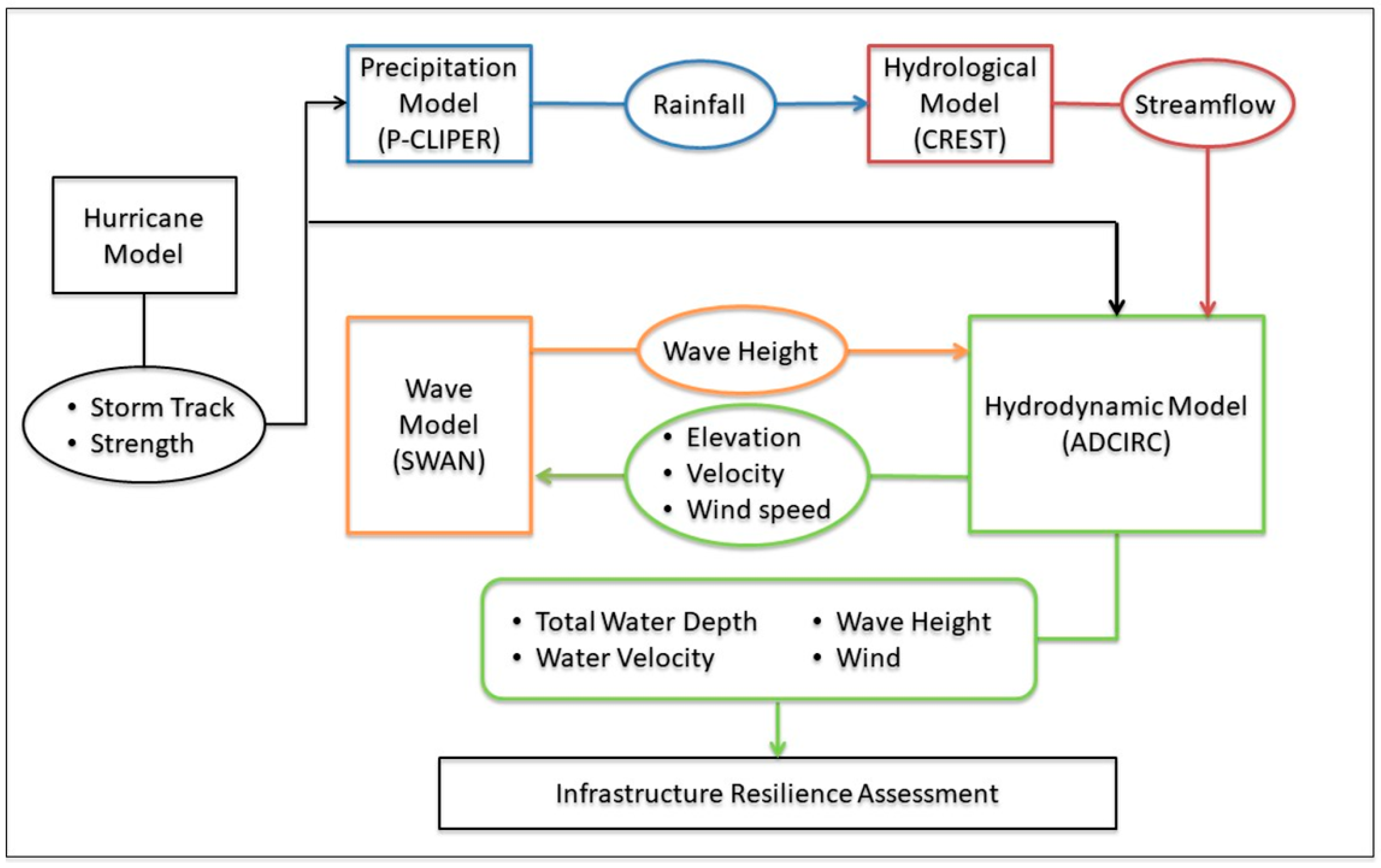
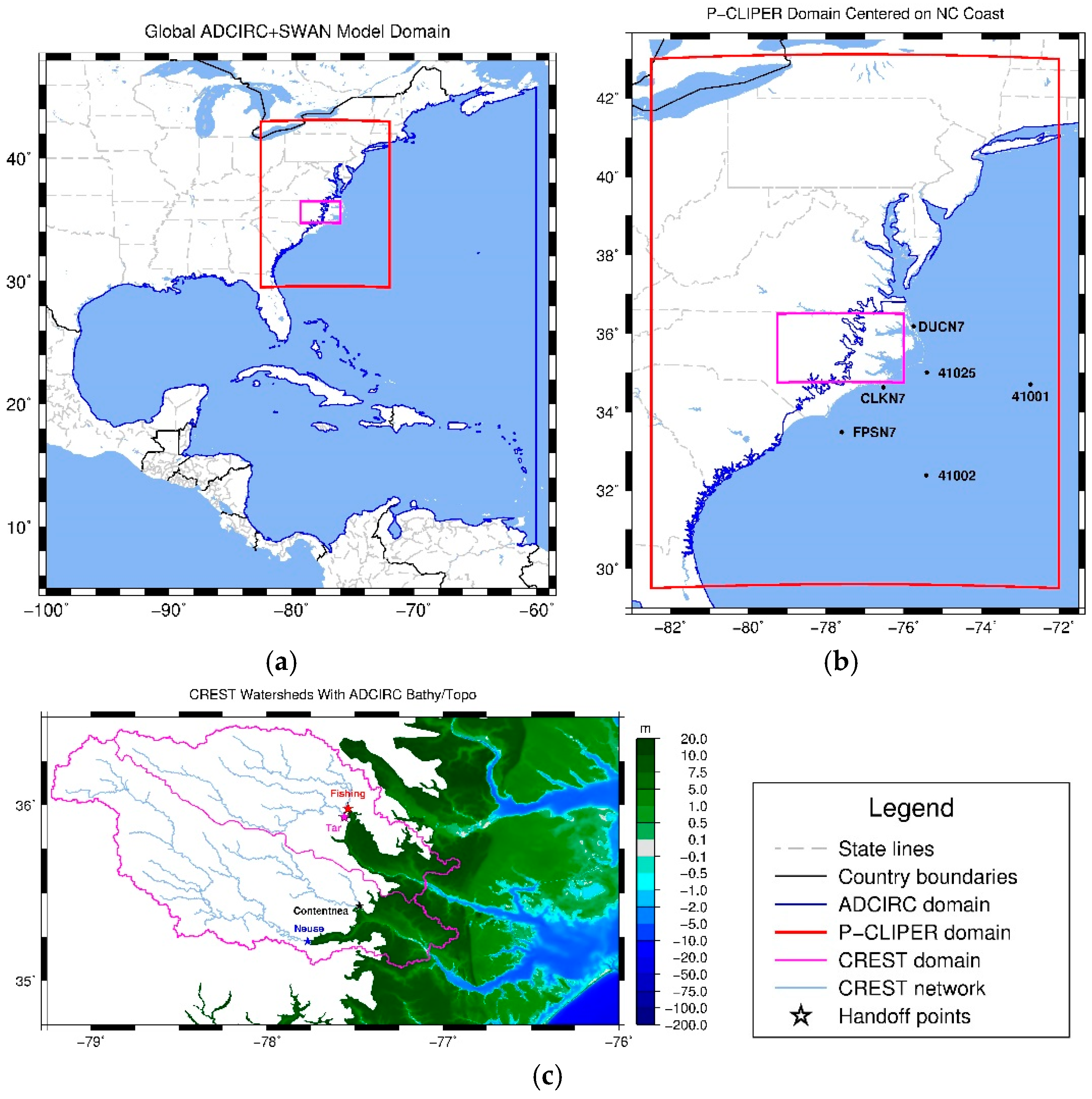
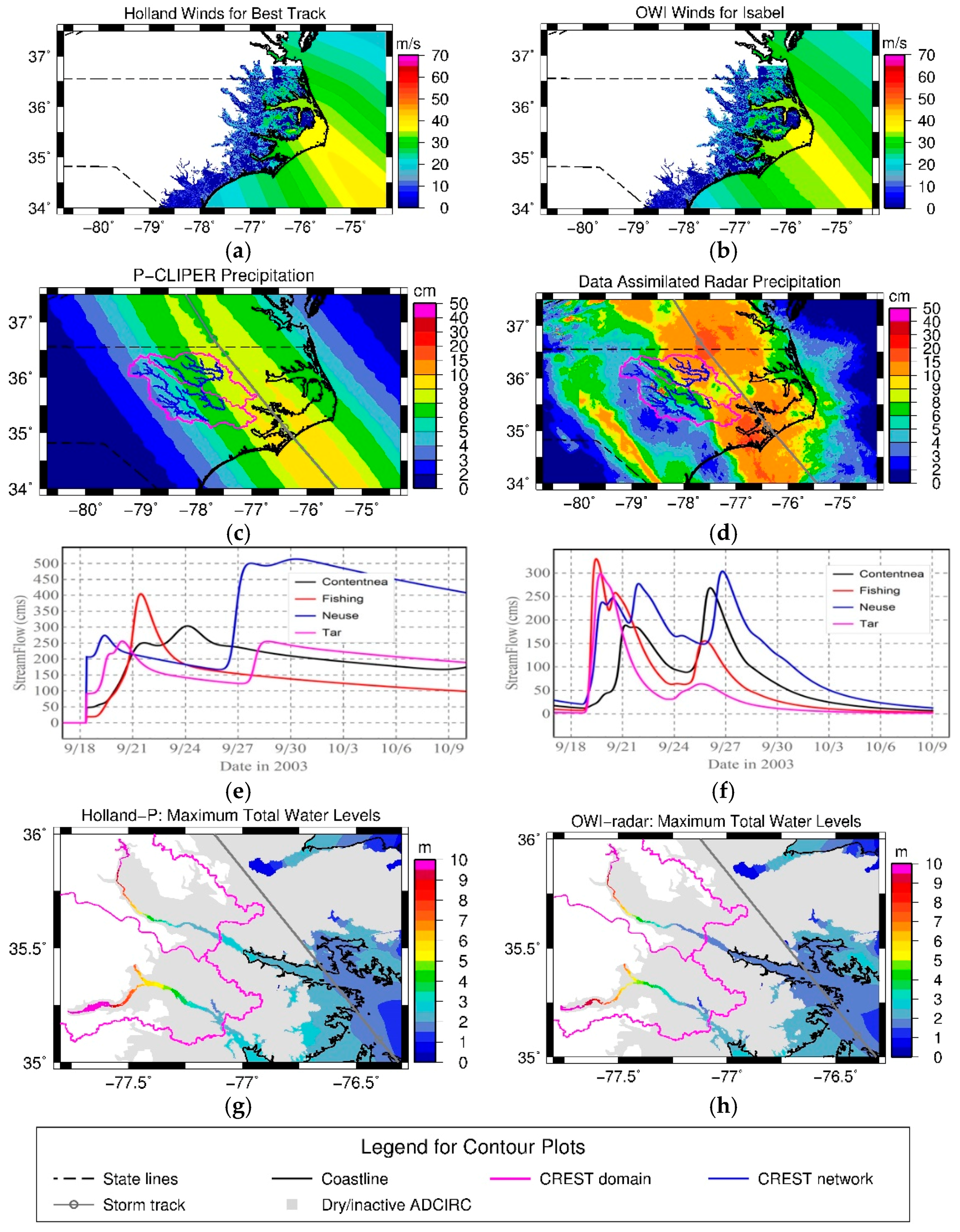
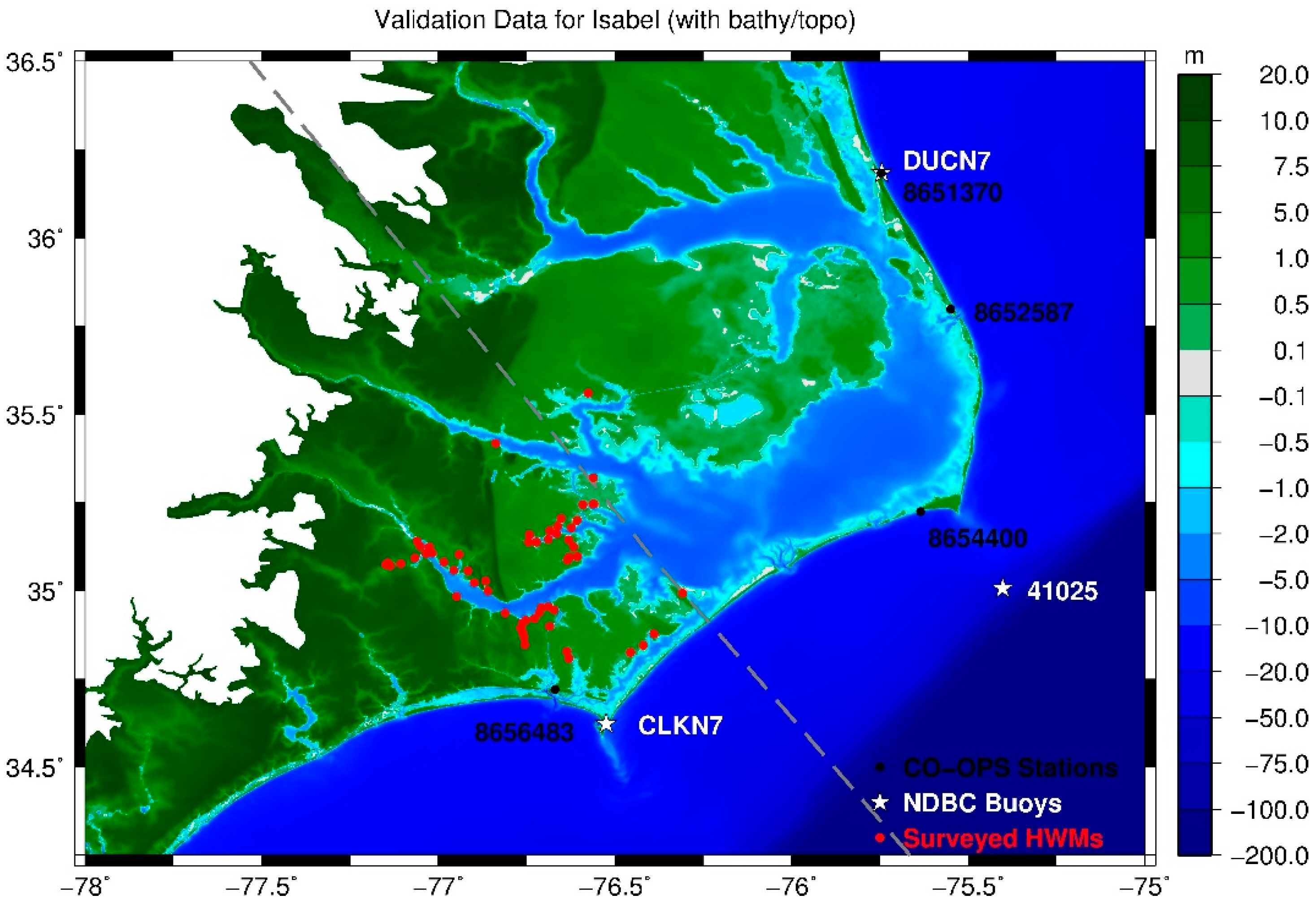
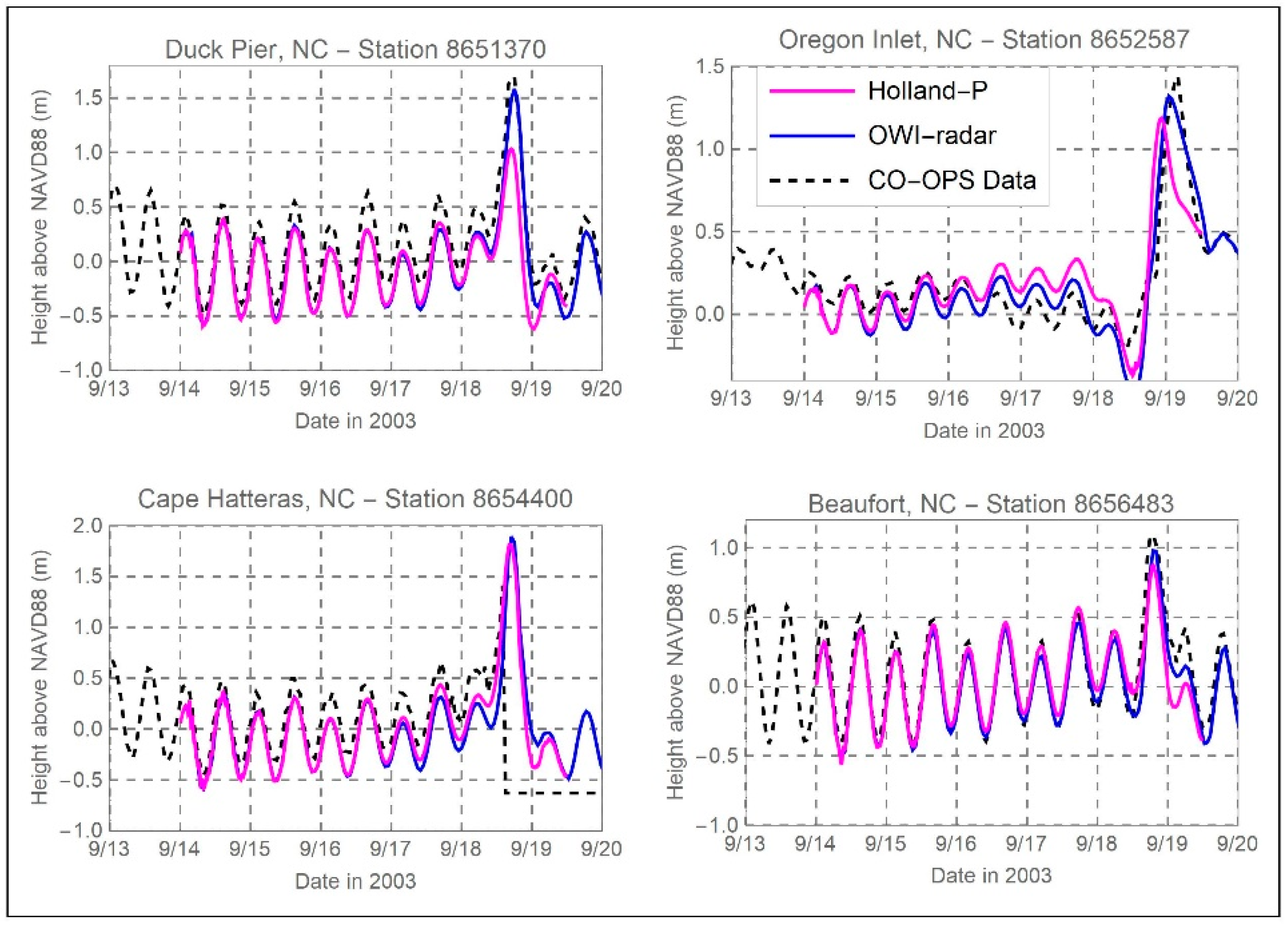
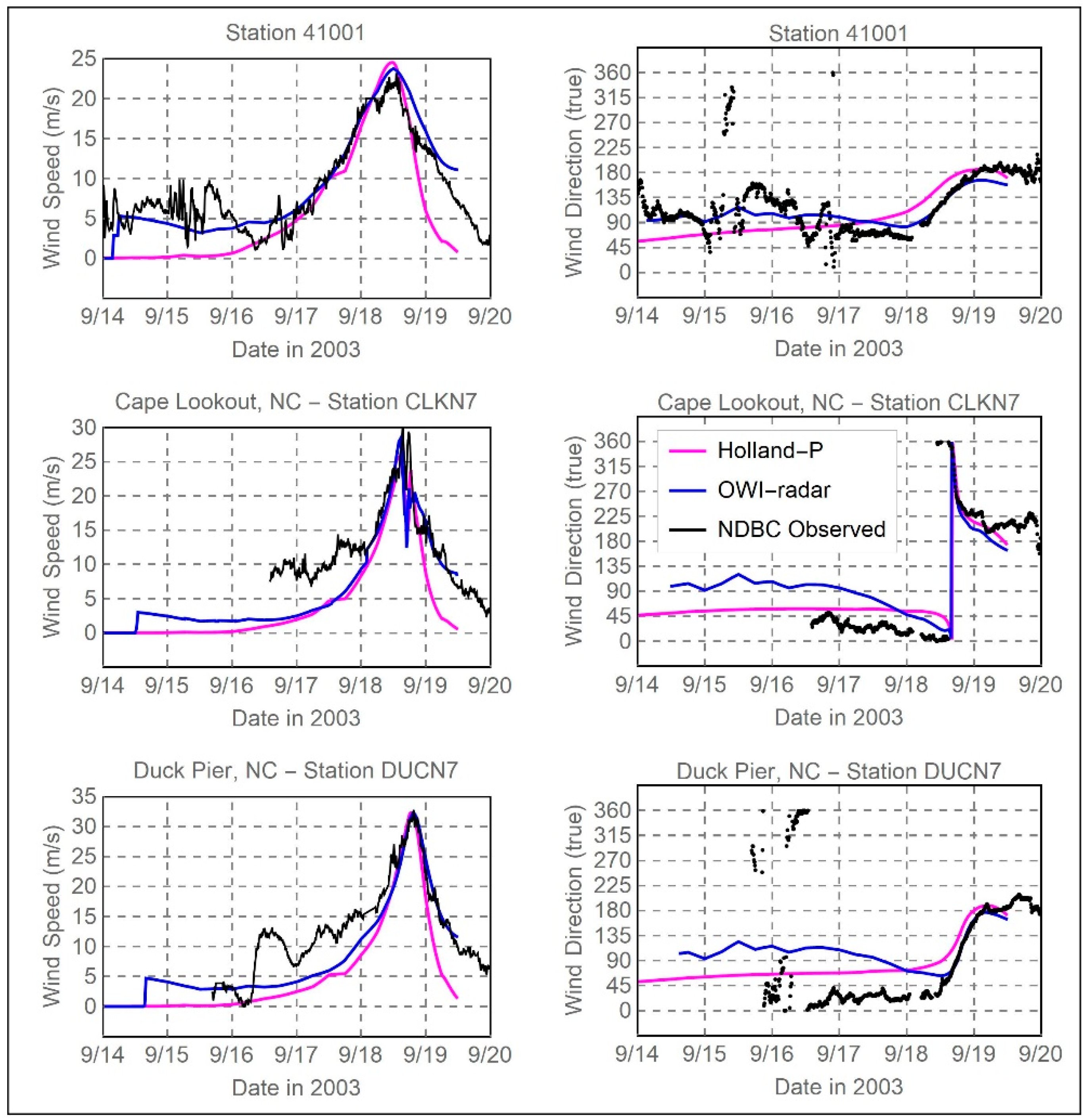
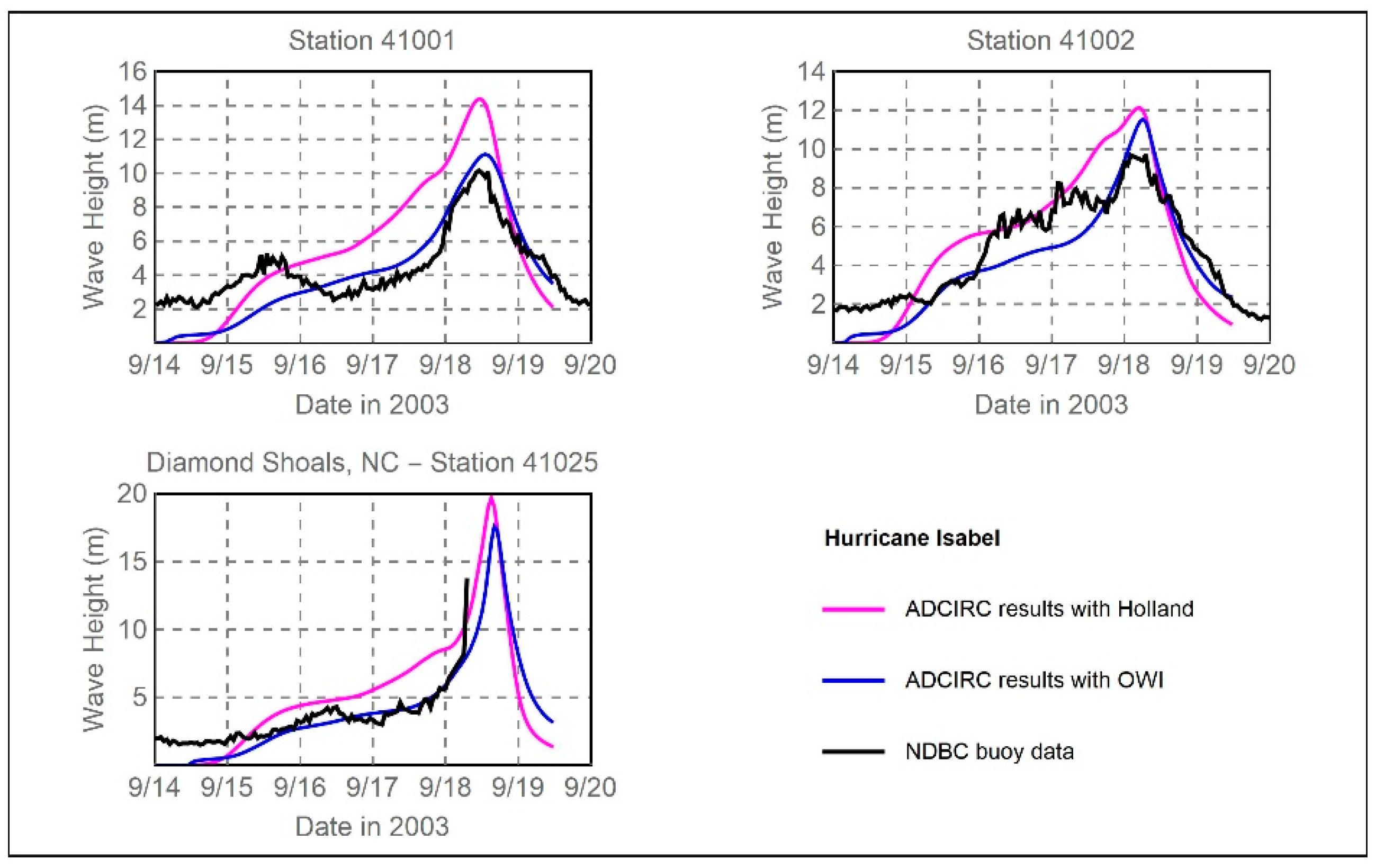

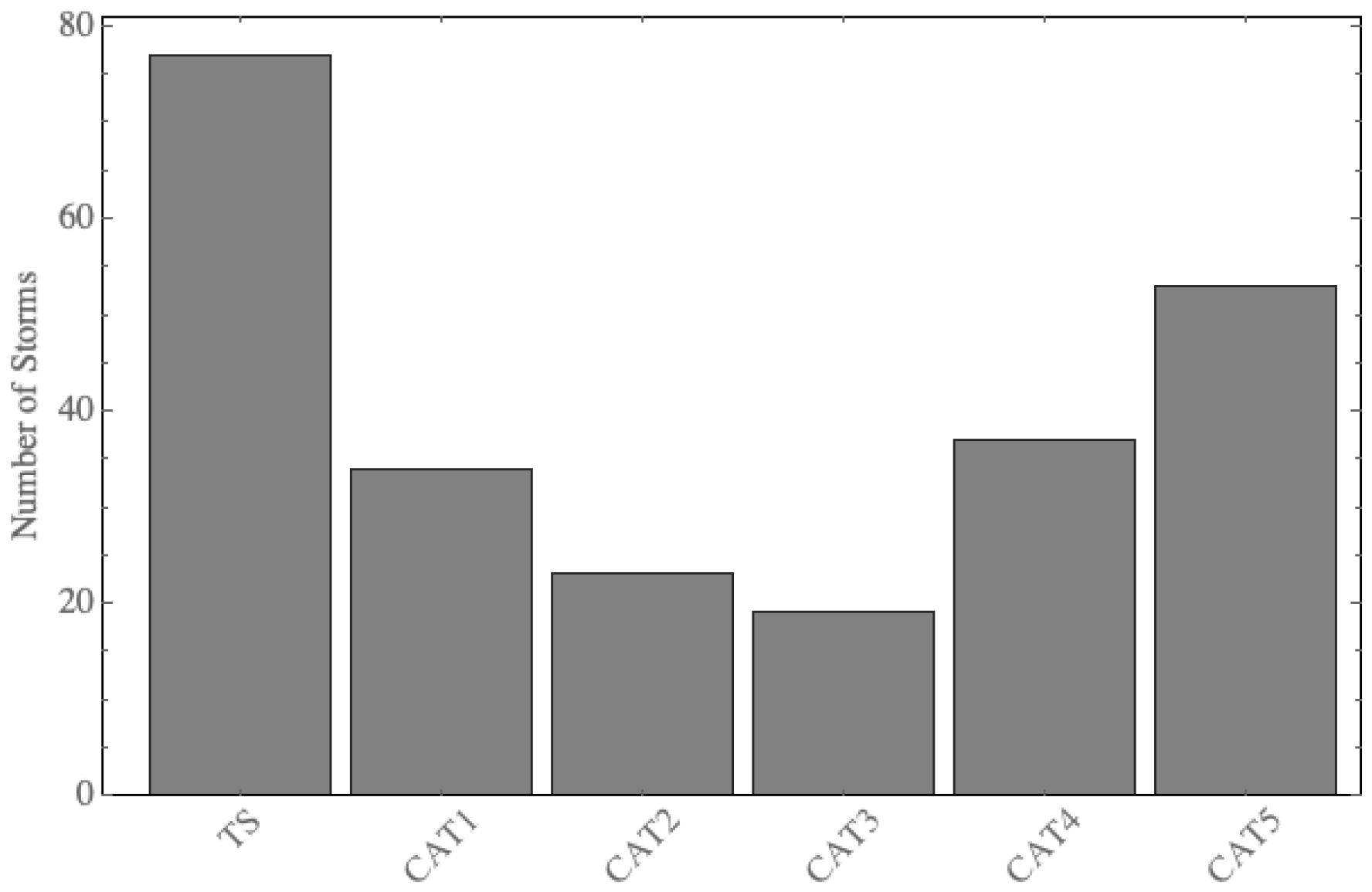
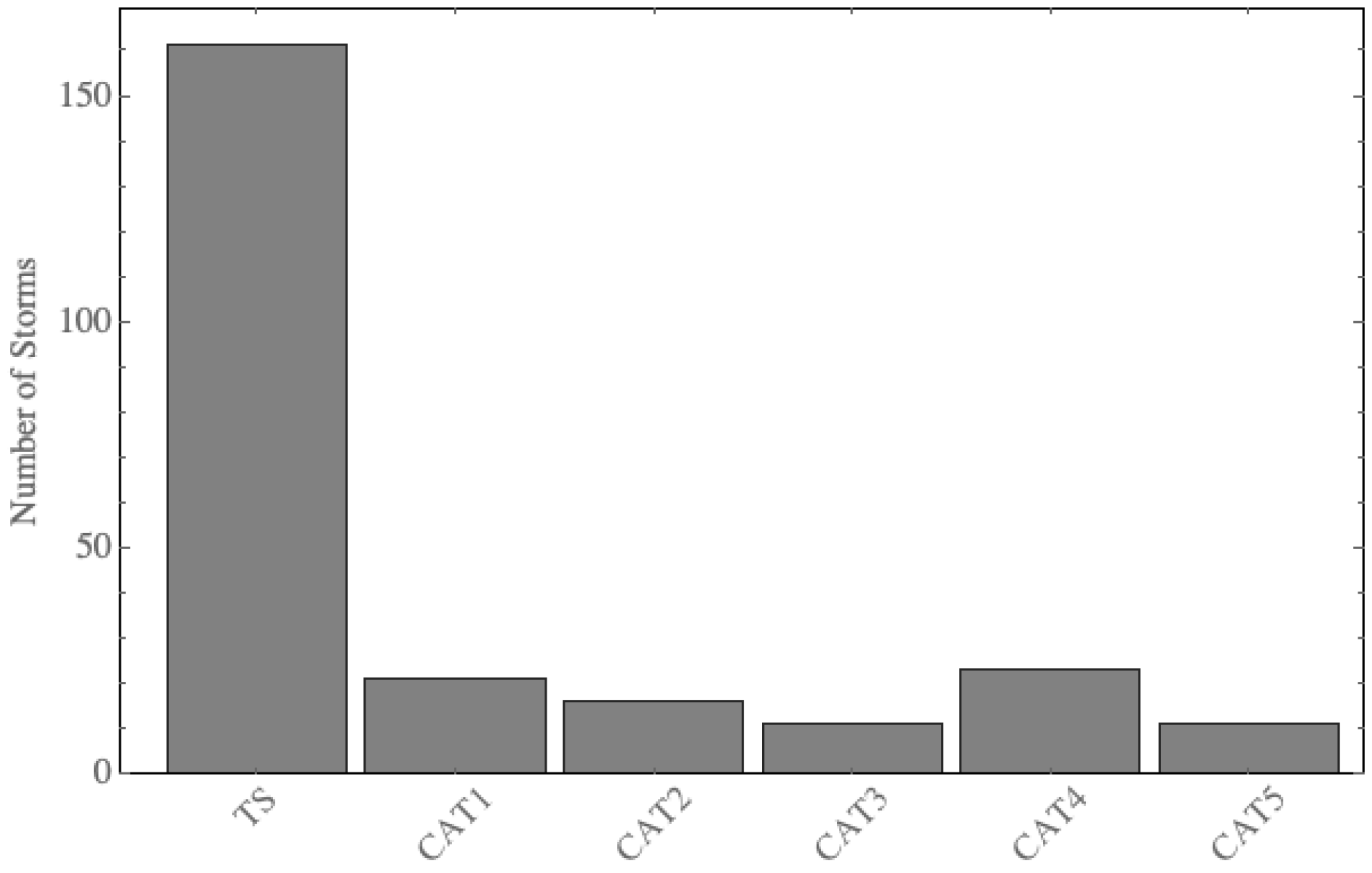
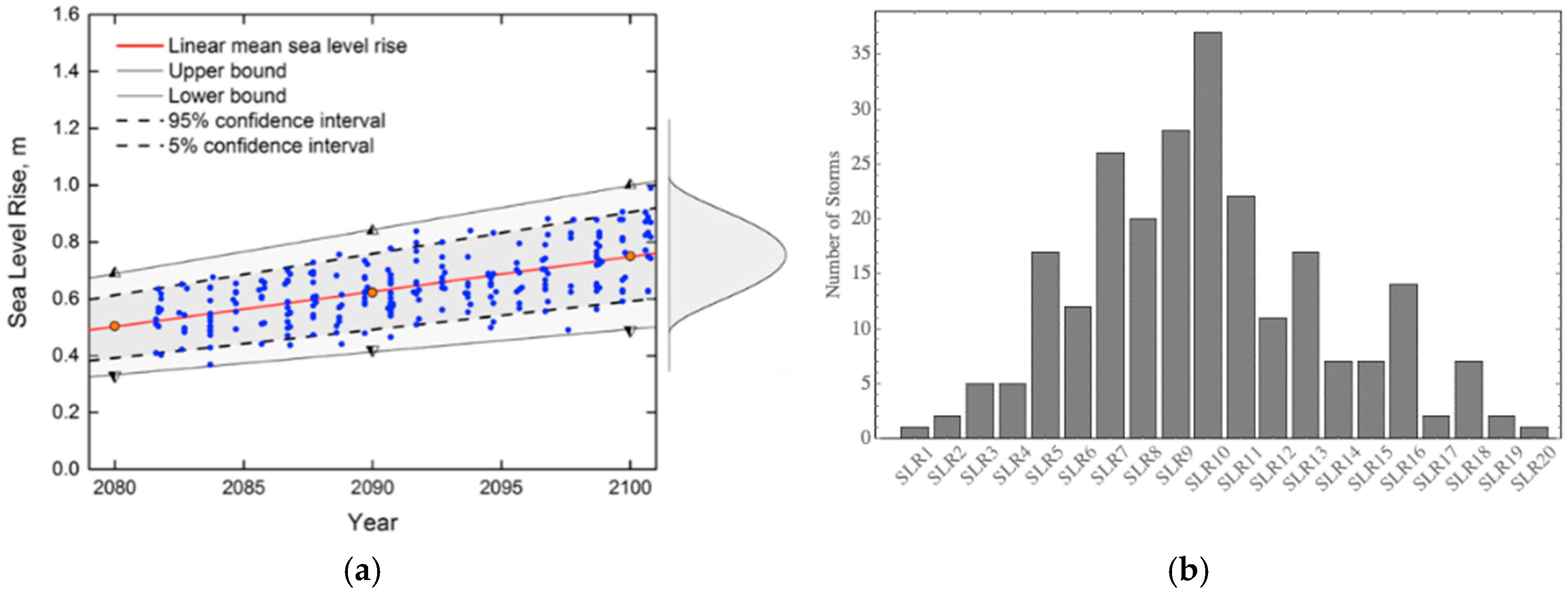

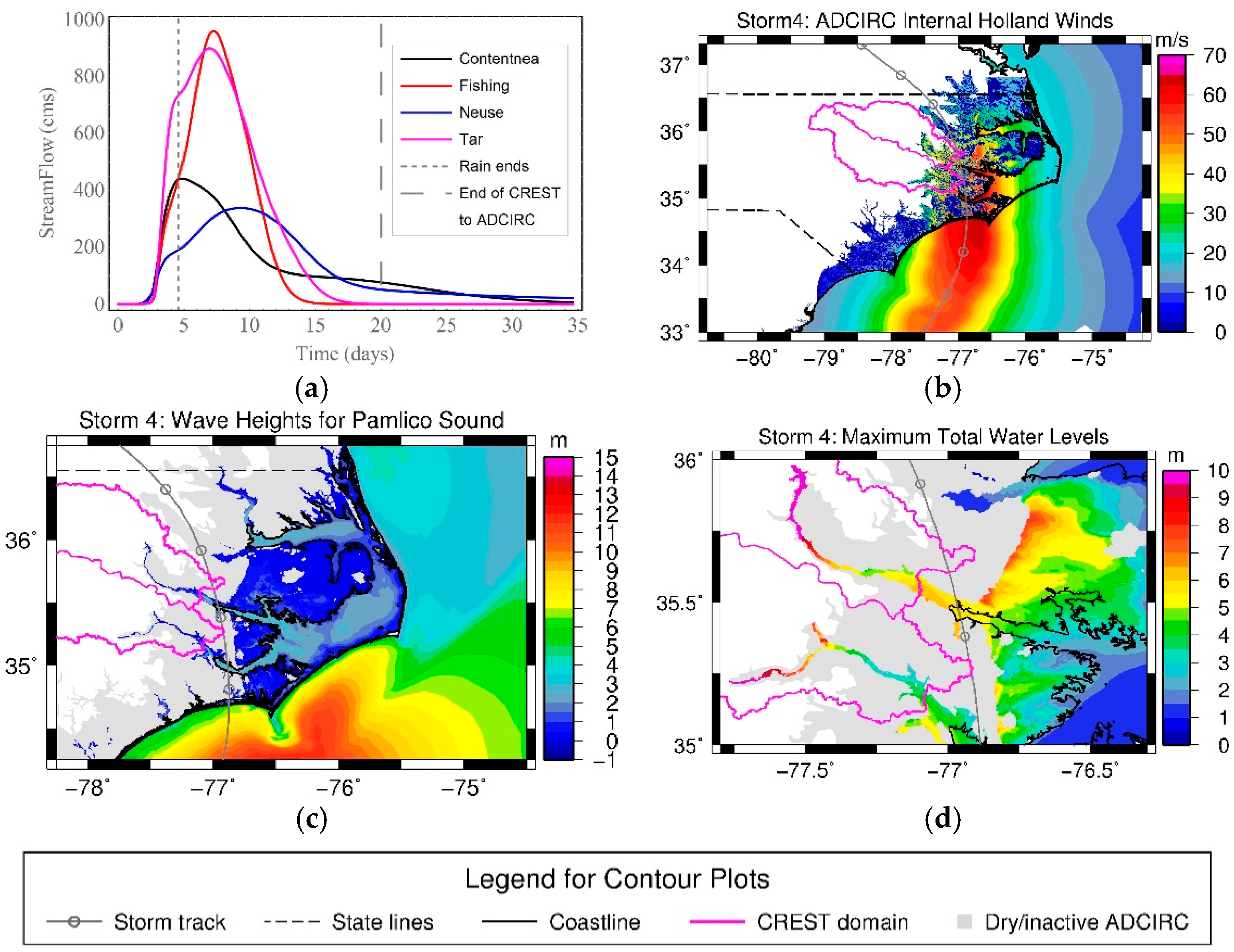
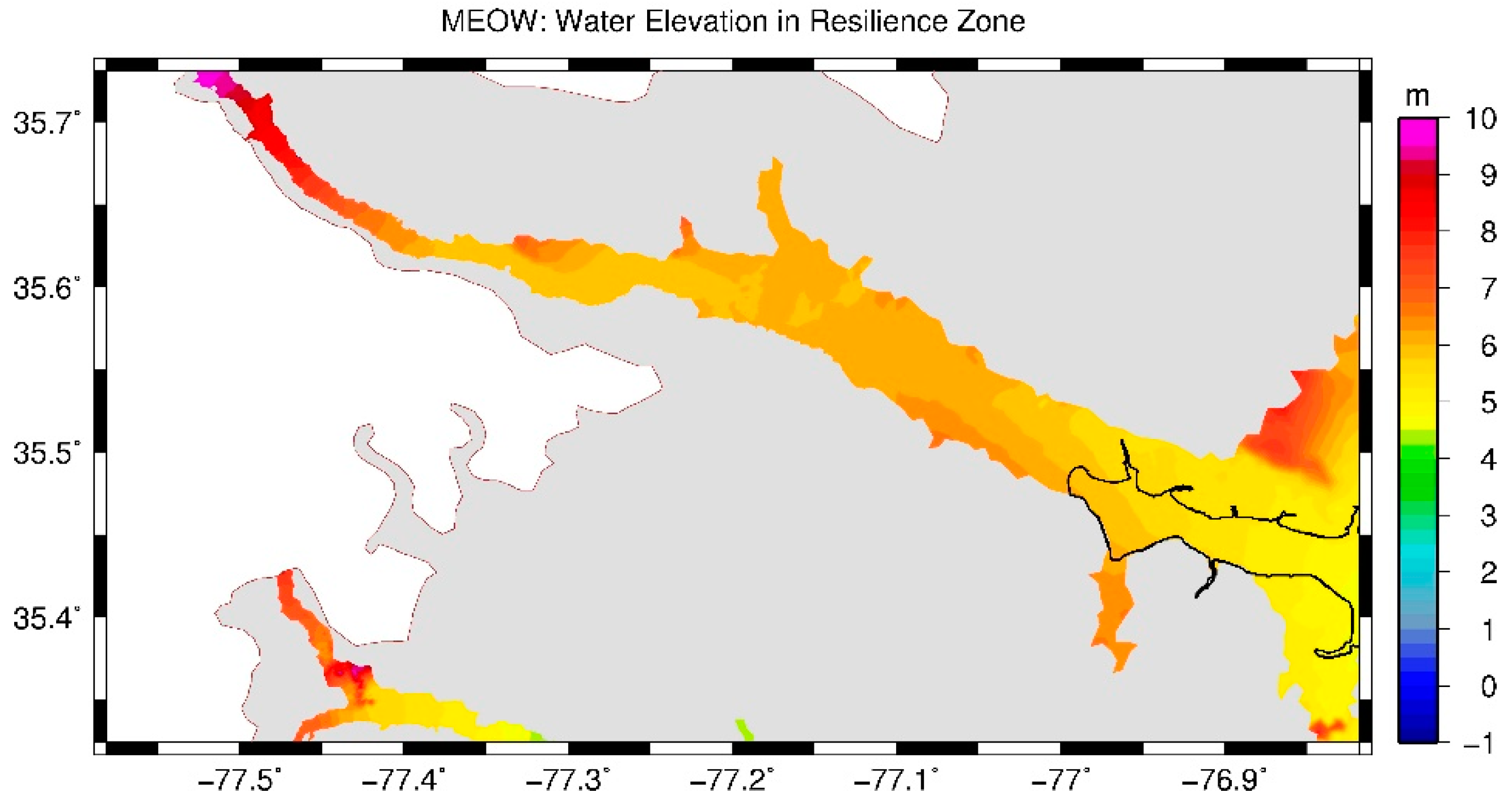
| Validation Step | Storm Track | Winds | Precipitation |
|---|---|---|---|
| STORM-CoRe | NOAA best track | Holland parameterized | P-CLIPER |
| Best Available | N/A | Data assimilated | Multi-sensor data analysis |
| RCP 8.5 Plus Vertical Land Movement | |||||
|---|---|---|---|---|---|
| Stations | Duck | Oregon Inlet | Beaufort | Wilmington | Southport |
| Relative Sea Level Rise by 2080 (meters) | |||||
| Mean | 0.55 | 0.51 | 0.51 | 0.47 | 0.48 |
| Low | 0.4 | 0.36 | 0.37 | 0.33 | 0.34 |
| High | 0.69 | 0.65 | 0.65 | 0.61 | 0.62 |
| 95% CI | 0.14 | 0.15 | 0.14 | 0.14 | 0.14 |
| Relative Sea Level Rise by 2090 (meters) | |||||
| Mean | 0.67 | 0.62 | 0.63 | 0.59 | 0.6 |
| Low | 0.5 | 0.45 | 0.46 | 0.42 | 0.43 |
| High | 0.84 | 0.8 | 0.8 | 0.76 | 0.77 |
| 95% CI | 0.17 | 0.18 | 0.17 | 0.17 | 0.17 |
| Relative Sea Level Rise by 2100 (meters) | |||||
| Mean | 0.81 | 0.75 | 0.76 | 0.71 | 0.72 |
| Low | 0.58 | 0.52 | 0.54 | 0.49 | 0.5 |
| High | 1.0 | 0.98 | 0.98 | 0.93 | 0.94 |
| 95% CI | 0.22 | 0.23 | 0.22 | 0.22 | 0.22 |
| Sea Level Rise (meters) | ||||
|---|---|---|---|---|
| SLR1: 0.3679 | SLR2: 0.4053 | SLR3: 0.4338 | SLR4: 0.4721 | SLR5: 0.4961 |
| SLR6: 0.5231 | SLR7: 0.5544 | SLR8: 0.5861 | SLR9: 0.6165 | SLR10: 0.6450 |
| SLR11: 0.6772 | SLR12: 0.7012 | SLR13: 0.7375 | SLR14: 0.7643 | SLR15: 0.7952 |
| SLR16: 0.8262 | SLR17: 0.8544 | SLR18: 0.8791 | SLR19: 0.9051 | SLR20: 0.9898 |
© 2019 by the authors. Licensee MDPI, Basel, Switzerland. This article is an open access article distributed under the terms and conditions of the Creative Commons Attribution (CC BY) license (http://creativecommons.org/licenses/by/4.0/).
Share and Cite
Dresback, K.M.; Szpilka, C.M.; Xue, X.; Vergara, H.; Wang, N.; Kolar, R.L.; Xu, J.; Geoghegan, K.M. Steps towards Modeling Community Resilience under Climate Change: Hazard Model Development. J. Mar. Sci. Eng. 2019, 7, 225. https://doi.org/10.3390/jmse7070225
Dresback KM, Szpilka CM, Xue X, Vergara H, Wang N, Kolar RL, Xu J, Geoghegan KM. Steps towards Modeling Community Resilience under Climate Change: Hazard Model Development. Journal of Marine Science and Engineering. 2019; 7(7):225. https://doi.org/10.3390/jmse7070225
Chicago/Turabian StyleDresback, Kendra M., Christine M. Szpilka, Xianwu Xue, Humberto Vergara, Naiyu Wang, Randall L. Kolar, Jia Xu, and Kevin M. Geoghegan. 2019. "Steps towards Modeling Community Resilience under Climate Change: Hazard Model Development" Journal of Marine Science and Engineering 7, no. 7: 225. https://doi.org/10.3390/jmse7070225
APA StyleDresback, K. M., Szpilka, C. M., Xue, X., Vergara, H., Wang, N., Kolar, R. L., Xu, J., & Geoghegan, K. M. (2019). Steps towards Modeling Community Resilience under Climate Change: Hazard Model Development. Journal of Marine Science and Engineering, 7(7), 225. https://doi.org/10.3390/jmse7070225





